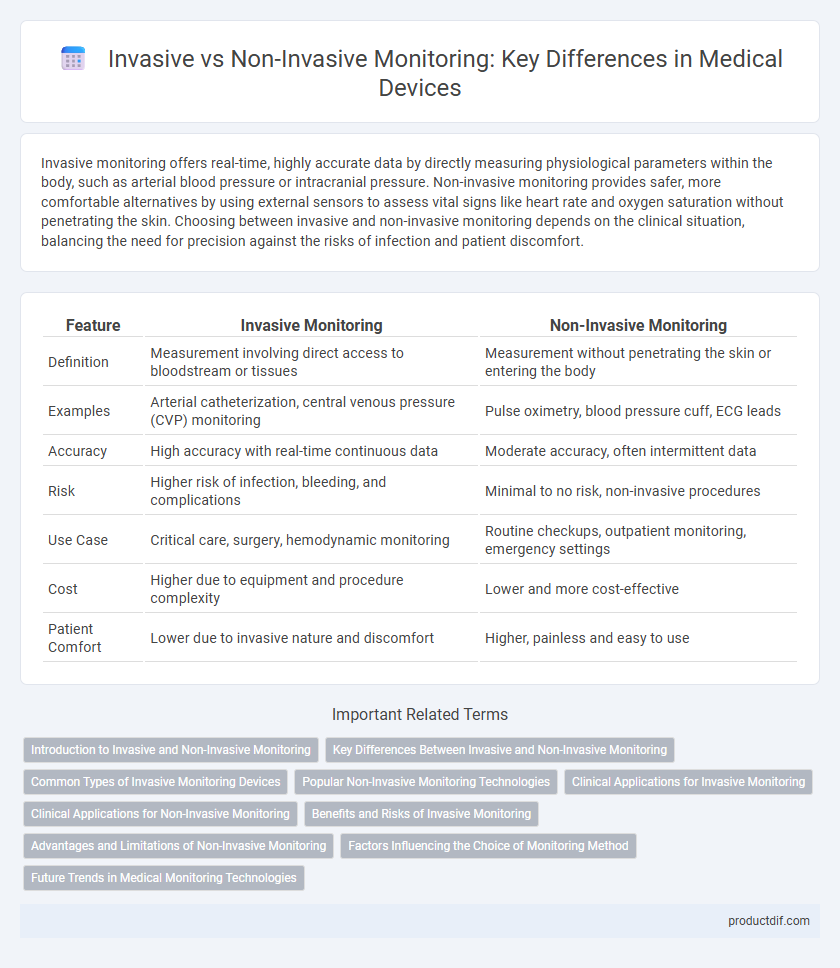Invasive monitoring offers real-time, highly accurate data by directly measuring physiological parameters within the body, such as arterial blood pressure or intracranial pressure. Non-invasive monitoring provides safer, more comfortable alternatives by using external sensors to assess vital signs like heart rate and oxygen saturation without penetrating the skin. Choosing between invasive and non-invasive monitoring depends on the clinical situation, balancing the need for precision against the risks of infection and patient discomfort.
Table of Comparison
| Feature | Invasive Monitoring | Non-Invasive Monitoring |
|---|---|---|
| Definition | Measurement involving direct access to bloodstream or tissues | Measurement without penetrating the skin or entering the body |
| Examples | Arterial catheterization, central venous pressure (CVP) monitoring | Pulse oximetry, blood pressure cuff, ECG leads |
| Accuracy | High accuracy with real-time continuous data | Moderate accuracy, often intermittent data |
| Risk | Higher risk of infection, bleeding, and complications | Minimal to no risk, non-invasive procedures |
| Use Case | Critical care, surgery, hemodynamic monitoring | Routine checkups, outpatient monitoring, emergency settings |
| Cost | Higher due to equipment and procedure complexity | Lower and more cost-effective |
| Patient Comfort | Lower due to invasive nature and discomfort | Higher, painless and easy to use |
Introduction to Invasive and Non-Invasive Monitoring
Invasive monitoring involves the direct measurement of physiological parameters through devices inserted into the body, such as arterial catheters or central venous lines, providing accurate and continuous data essential for critical care. Non-invasive monitoring utilizes external sensors and techniques like pulse oximetry, blood pressure cuffs, and ECG electrodes, offering patient comfort and reduced risk of infection. Selecting between invasive and non-invasive methods depends on the clinical scenario, required accuracy, and patient condition.
Key Differences Between Invasive and Non-Invasive Monitoring
Invasive monitoring involves direct access to the body's internal environment through catheters or sensors inserted into blood vessels or tissues, providing real-time, highly accurate data on parameters such as arterial pressure and blood gases. Non-invasive monitoring relies on external devices like pulse oximeters, blood pressure cuffs, or ECG electrodes to collect physiological data without penetrating the skin, offering ease of use and lower risk of infection but potentially reduced precision. The choice between invasive and non-invasive monitoring hinges on clinical needs, balancing accuracy and risk, with invasive methods preferred in critical care settings requiring continuous and precise measurement.
Common Types of Invasive Monitoring Devices
Common types of invasive monitoring devices include arterial catheters, central venous catheters, and pulmonary artery catheters, which provide real-time, accurate measurements of blood pressure, central venous pressure, and cardiac output. These devices are essential in critical care settings for precise hemodynamic monitoring and management of patients with severe cardiovascular conditions. Invasive monitoring offers continuous data that is crucial for guiding treatment decisions and improving patient outcomes.
Popular Non-Invasive Monitoring Technologies
Popular non-invasive monitoring technologies in medical devices include pulse oximetry, capnography, and photoplethysmography, enabling continuous assessment of oxygen saturation, respiratory status, and blood volume changes without breaching the skin. These technologies offer real-time data with minimal patient discomfort and reduced risk of infection compared to invasive methods such as arterial catheterization or central venous pressure monitoring. Advances in wearable sensors and optical devices have further enhanced accuracy and accessibility in critical care and outpatient settings.
Clinical Applications for Invasive Monitoring
Invasive monitoring is extensively utilized in critical care settings for continuous and accurate assessment of hemodynamic parameters such as arterial blood pressure, central venous pressure, and intracranial pressure. Clinical applications include cardiac catheterization for diagnosing coronary artery disease, pulmonary artery catheterization to guide fluid management in heart failure, and intracranial pressure monitoring in traumatic brain injury patients. These techniques provide real-time data essential for precise therapeutic interventions and improved patient outcomes in intensive care units.
Clinical Applications for Non-Invasive Monitoring
Non-invasive monitoring techniques are extensively utilized in clinical settings for continuous assessment of vital signs such as blood pressure, oxygen saturation, and heart rate without penetrating the skin. Common devices include pulse oximeters, electrocardiograms (ECG), and wearable blood pressure monitors, which enhance patient comfort and reduce the risk of infection. These methods are particularly valuable in intensive care units, outpatient clinics, and during perioperative care for real-time, low-risk patient monitoring.
Benefits and Risks of Invasive Monitoring
Invasive monitoring provides continuous, precise measurements of critical parameters such as arterial blood pressure and intracranial pressure, enabling real-time management of critically ill patients. Its benefits include superior accuracy and early detection of physiological changes, crucial for guiding intensive care interventions. However, the risks involve potential complications like infection, thrombosis, and vascular injury due to catheter insertion, requiring stringent aseptic techniques and skilled personnel.
Advantages and Limitations of Non-Invasive Monitoring
Non-invasive monitoring offers significant advantages such as reduced risk of infection, improved patient comfort, and easier repeated measurements compared to invasive techniques. Its limitations include lower accuracy in certain critical parameters, susceptibility to motion artifacts, and challenges in continuous real-time data collection. Despite these constraints, non-invasive monitoring remains essential in outpatient settings and long-term patient management due to its safety and convenience.
Factors Influencing the Choice of Monitoring Method
Factors influencing the choice between invasive and non-invasive monitoring in medical devices include patient condition, required accuracy, and risk of complications. Invasive monitoring provides continuous, precise data but carries higher infection risk and is typically reserved for critically ill patients. Non-invasive methods offer safer, easier application with less discomfort, suitable for routine monitoring or stable patients.
Future Trends in Medical Monitoring Technologies
Future trends in medical monitoring technologies emphasize the integration of advanced sensors and AI algorithms to enhance both invasive and non-invasive monitoring accuracy. Non-invasive methods, driven by wearable devices and continuous real-time data collection, are expanding their capabilities to detect complex physiological parameters traditionally measured invasively. The convergence of minimally invasive techniques with AI-powered predictive analytics is set to revolutionize patient monitoring by improving early diagnosis and personalized treatment plans.
Invasive Monitoring vs Non-Invasive Monitoring Infographic

 productdif.com
productdif.com